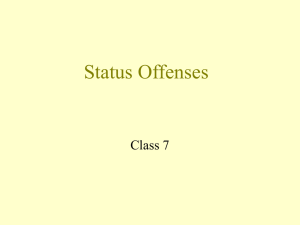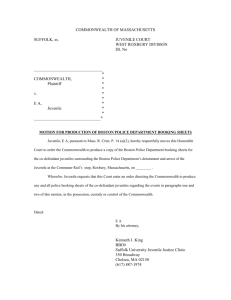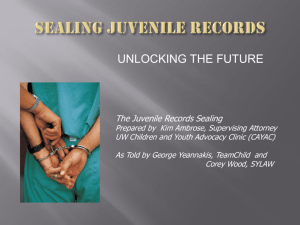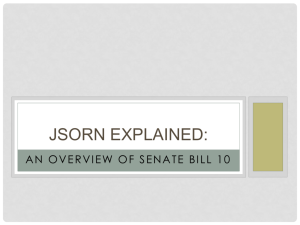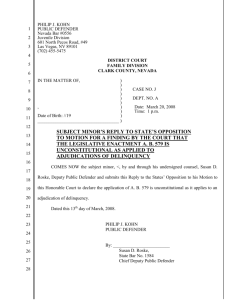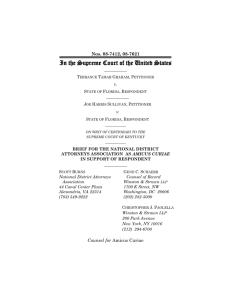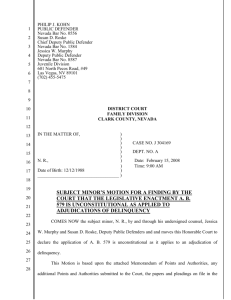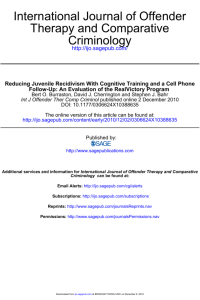Oct 07 09 O6:17p Michael A Feit, Esq
advertisement
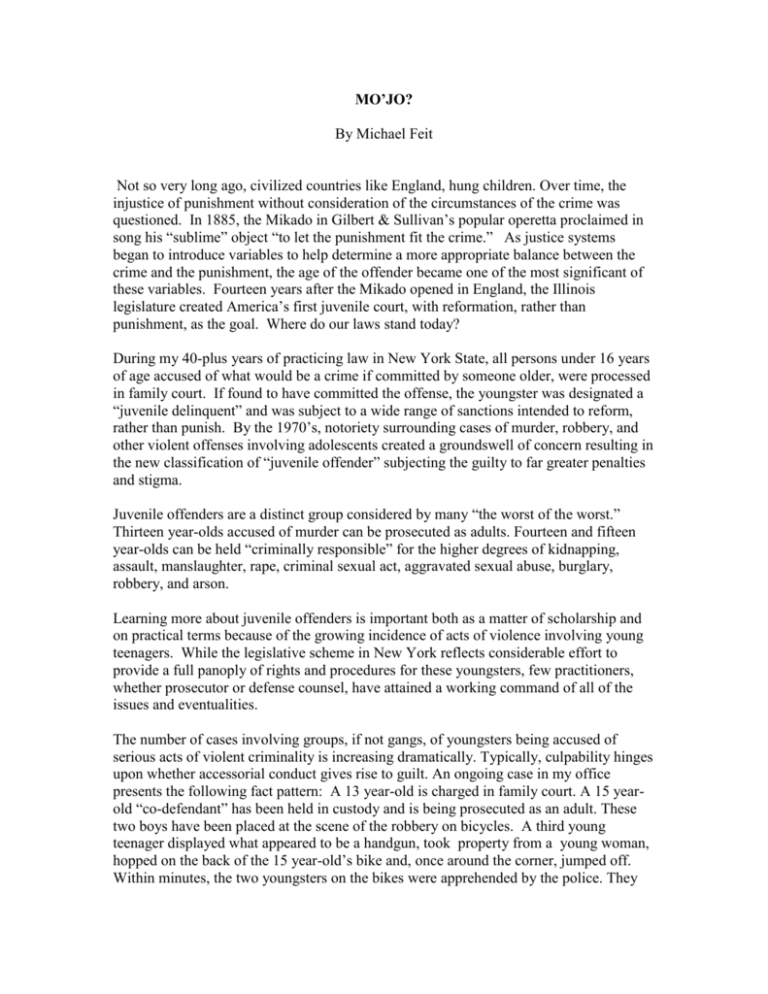
MO’JO? By Michael Feit Not so very long ago, civilized countries like England, hung children. Over time, the injustice of punishment without consideration of the circumstances of the crime was questioned. In 1885, the Mikado in Gilbert & Sullivan’s popular operetta proclaimed in song his “sublime” object “to let the punishment fit the crime.” As justice systems began to introduce variables to help determine a more appropriate balance between the crime and the punishment, the age of the offender became one of the most significant of these variables. Fourteen years after the Mikado opened in England, the Illinois legislature created America’s first juvenile court, with reformation, rather than punishment, as the goal. Where do our laws stand today? During my 40-plus years of practicing law in New York State, all persons under 16 years of age accused of what would be a crime if committed by someone older, were processed in family court. If found to have committed the offense, the youngster was designated a “juvenile delinquent” and was subject to a wide range of sanctions intended to reform, rather than punish. By the 1970’s, notoriety surrounding cases of murder, robbery, and other violent offenses involving adolescents created a groundswell of concern resulting in the new classification of “juvenile offender” subjecting the guilty to far greater penalties and stigma. Juvenile offenders are a distinct group considered by many “the worst of the worst.” Thirteen year-olds accused of murder can be prosecuted as adults. Fourteen and fifteen year-olds can be held “criminally responsible” for the higher degrees of kidnapping, assault, manslaughter, rape, criminal sexual act, aggravated sexual abuse, burglary, robbery, and arson. Learning more about juvenile offenders is important both as a matter of scholarship and on practical terms because of the growing incidence of acts of violence involving young teenagers. While the legislative scheme in New York reflects considerable effort to provide a full panoply of rights and procedures for these youngsters, few practitioners, whether prosecutor or defense counsel, have attained a working command of all of the issues and eventualities. The number of cases involving groups, if not gangs, of youngsters being accused of serious acts of violent criminality is increasing dramatically. Typically, culpability hinges upon whether accessorial conduct gives rise to guilt. An ongoing case in my office presents the following fact pattern: A 13 year-old is charged in family court. A 15 yearold “co-defendant” has been held in custody and is being prosecuted as an adult. These two boys have been placed at the scene of the robbery on bicycles. A third young teenager displayed what appeared to be a handgun, took property from a young woman, hopped on the back of the 15 year-old’s bike and, once around the corner, jumped off. Within minutes, the two youngsters on the bikes were apprehended by the police. They had no gun and no “loot” from the robbery. The boy who jumped off the bike has yet to be arrested or charged. In such cases, removal to family court for the 15 year-old would ordinarily be perceived as desirable. However, while family court sanctions are not as far-reaching, no trial by jury is available. Thus, in many cases, removal may result in a questionable trade-off. Statutory guidance to the practitioner on how to proceed requires a bit of resourcefulness and ingenuity. The defense of infancy has been around for a long time, and although worthy of exploration, the manner in which primitive cultures addressed the issue of whether “an eye for an eye” included toddlers, will not be considered here. Roots for the planting and cultivation of the juvenile offender paradigm are best unearthed by statutory reference. In New York, Article 30 of the Penal Law is the place to begin. The road map leads to Section 725.10 of the Criminal Procedure Law, which provides for removal to family court. Cases being prosecuted in criminal court point counsel to the following statutory references: CPL 180.75 - Proceedings on felony complaint; juvenile offender CPL 190.71 - Grand Jury: Direction to file request for removal to family court CPL 210.43 - Motion to remove juvenile offender to family court CPL 220.10- Pleas CPL 310.85 - Verdict of guilty where defendant not criminally responsible CPL 330.25 - Removal after verdict The process for juvenile offenders in many ways parallels the statutory scheme for adults, but with even deeper pitfalls. When offenses are particularly violent, prosecutors and judges are reluctant to offer much consideration even to those of tender years. Hard pressed to keep pace with burgeoning caseloads, public defenders, conflict defenders, legal aid lawyers, and assigned counsel will more often than not be unable and perhaps unwilling to devote extra time and energy to attempt to understand youthful criminal conduct. Few enlist the help of professionals who might offer promise of treatment and/or guidance. Patience in providing representation is virtuous. “My client hasn’t robbed anyone in two months,” might be the best you can say. If the person your client has robbed, assaulted, or murdered is less sympathetic than the accused, advancing such an argument might influence the prosecutor to cut your client some slack. Adult defendants rarely suggest a meaningful rationale for their conduct. Children, without as thick a patina of practiced avoidance and denial, might offer clues to how and why they should be permitted to remain on the streets. The single greatest contributing factor in attempting to explain why youngsters violate the law is that they have no meaningful and viable concept of the future. Being deterred from knocking over a convenience store because the arrest might not look good on a medical school application is rarely a consideration. Many never ponder the probabilities of being caught and even the few who do are unlikely to care. The statutory scheme for juvenile offenders in New York has been in place since 1978. Legislative history suggests substantial planning and reminds us that heightened efforts must be made in the representation of all persons accused of crimes. Beyond the scope of detention center consultations with 13, 14, and 15 year-olds, advocates must reach out to parent(s), school(s), and other available resources. Exhuming relevant constructive elements from the past and coming up with plans for a meaningful future will certainly help to influence decision-makers like prosecutors and judges. Promulgation and perpetuation of juvenile offenders into a separate legal classification is an admission of failure. The construct only heaps greater penalties on youth, with nothing to turn their lives around. Like laws on terrorism, juvenile offender laws may momentarily make the public feel that they are living in a safer world, but simply coming up with a new title does not begin to address the problems of violence in our society. Ascribing reasons for why kids might become armed robbers is difficult. Far more daunting is concocting the formula to prevent such acts in the future. America is a nation of numbers. Statistics rule the world of sport -- recitation of the number of home runs, touchdowns, three-pointers roll off so many lips. Not until new numbers for juvenile offenders are counted will there be any chance for change. How about -- most days (hours?) without smoking weed? fewest tattoos? fewest minutes holding a firearm? most consecutive days in school? greatest number of compliments given in a year? Until government displays far greater sensitivity to the issue and designs more innovative approaches, participants will be left playing tennis with wooden racquets, sending messages by telegraph, and telling time with an hour glass. Willie Sutton, a famous bank robber of the past, was once asked why he robbed banks. He said: “Because that’s where the money is.” After doing his time, Willie became a consultant for banks and taught bankers how to prevent robberies. When it comes to juvenile offender protocols, maybe we’re asking the wrong people. * * * Michael A. Feit, Esq. Graduated from Eastside High School in Paterson, New Jersey, made famous by the movie Lean on Me. He received an A.B. from Syracuse University, a J.D. from the University of Chicago Law School, and an MA. from the School of Criminal Justice at the University at Albany. Two years as Chief of the Bureau of Appeals, Albany County District Attorney’s Office was followed by 40 years in private practice, the last 10 also serving as an Assistant Albany County Public Defender. During those last 10 years, he has become known as the Lawyer in the Hood. When asked directions to his office, he frequently begins: “My office is in Arbor Hill, not Beverly Hills.” Mr. Feit has written two novels, contributed to many professional publications and, just to keep busy this Spring and Summer, appeared as an actor in Cat on a Hot Tin Roof and Much Ado About Nothing. He can be reached at FeitEsq@aol.com.



